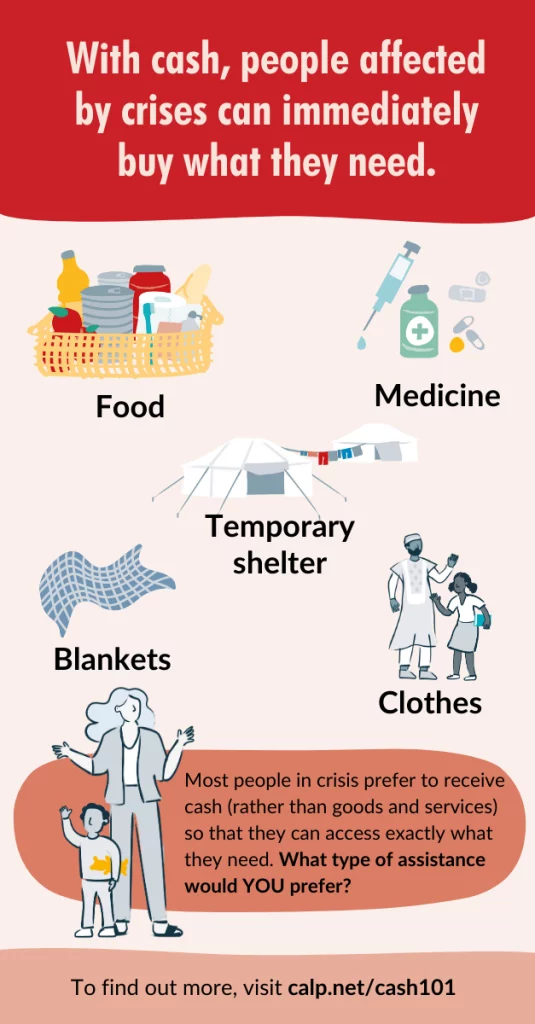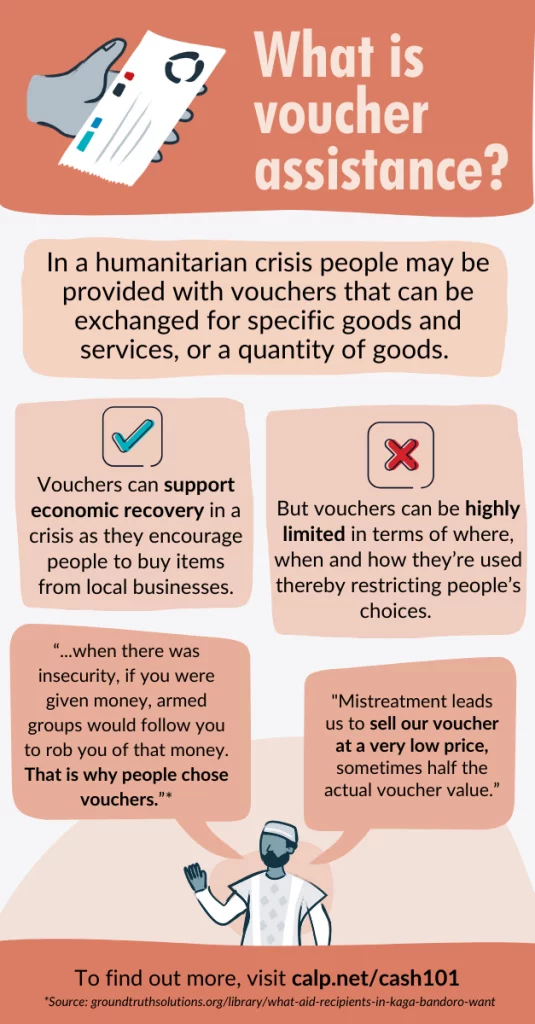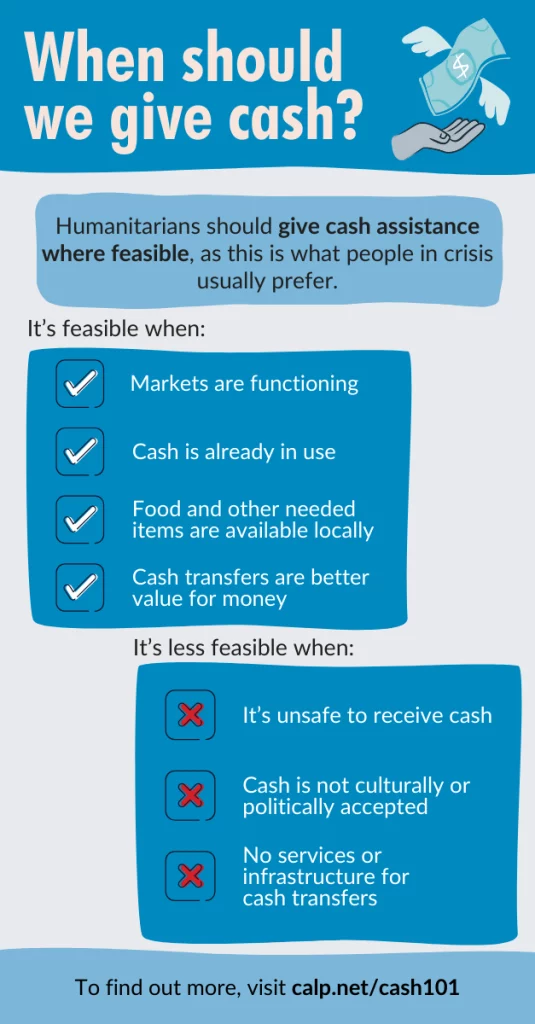Cash, Vouchers and In-Kind Goods and Services

When a disaster strikes, aid actors will ask what type of aid will provide the most effective and appropriate assistance to affected people. Among other types of aid, responders might consider cash and voucher assistance, in-kind goods and services, or a combination of both.
On this page, we look at the advantages and challenges of each form of assistance (each modality), as well as examples of different types of aid in action.
What does in-kind assistance mean?
In-kind assistance is a type of humanitarian assistance where people affected by a crisis receive goods or services such as:
- Food packages
- Shelter
- Other non-food items, such as blankets, soap, buckets, or cooking pots and utensils
- Health services
- Education.
Providing people with goods and services is a well-known form of humanitarian assistance. But, in recent years, a steadily increasing amount of humanitarian assistance is being provided in the form of cash and vouchers (CVA).
In-kind assistance can sometimes be the most appropriate form of assistance in some situations. For example, in if markets are destroyed after a flood or earthquake, in-kind support may be needed until they start to recover.
However, in most situations, most people prefer cash to in-kind assistance. This is because cash offers much greater choice and dignity, in contrast people have little influence over what in-kind assistance they are given with choices made by the organisations or government providing the aid. At times, this can result in unsuitable items being distributed.

Is CVA more effective than in-kind?
Cash and voucher assistance offers many unique advantages over other forms of aid:
- It is usually preferred by recipients.
- It enables people to meet their needs according to their preferences, thus providing choice and dignity.
- It is usually more cost-effective than in-kind assistance once systems are established.
- It can stimulate the local economy and contribute to economic recovery – often referred to as the ‘multiplier effect’.
- It can help increase financial inclusion for people affected by crisis.
Despite this, CVA is not always the best form of aid (for example if markets have collapsed).
Aid providers carry out assessments to decide what type of assistance is most suitable in a particular context.
For full information please visit the benefits of CVA page on the Cash 101.
What are vouchers? Are they more effective than cash transfers?
Cash and voucher assistance is an umbrella term covering two very different ways of providing financial support to people in crisis. Vouchers are paper or electronic tokens that can be exchanged for a set value, quantity or type of goods or service. Vouchers are more restrictive than cash transfers, as they can only be exchanged for certain items, with certain vendors and often have an expiry date.
There are different types of vouchers:
- Commodity vouchers allow recipients to collect goods of a fixed, specified quantity and type directly from a vendor. This sort of voucher provides proof of entitlement rather than value. Given the lack of recipient choice, this approach is more accurately categorized as in-kind assistance , with vendors playing the role of distributor.
- Value vouchers have a cash value (e.g., $20) and can be redeemed at pre-determined vendors or service providers, such as a grocery stores, who are participating in the scheme. They provide more flexibility and choice than commodity vouchers but are still restricted e.g., it might only be possible to redeem them at certain places, or for certain items or within a limited time.
Using vouchers can encourage people to buy specific services or items from local markets and support businesses and economic recovery following a crisis. Money goes to local traders, who can spend their profits on other goods and services in the area, helping grow the local economy. This type of assistance often goes hand in hand with programmes that are helping local businesses to rebuild stocks and access goods to ensure supply.

But vouchers have been criticised as:
- Being too restrictive, as there are limits on what and where people can buy items.
- Open to exploitation, as vendors may provide bad quality items as they have a captured market.
- People may want other items, leading them to sell their vouchers for a lower cash amount than their value.
Most evidence shows that people prefer to receive cash transfers rather than vouchers as they offer greater flexibility and choice. This is widely acknowledged at a policy level which is reflected in the fact that 81% of CVA was delivered via cash in 2022, whereas only 19% was delivered as vouchers.
Case study: Is Cash Better Than Food Vouchers for Syrian Refugees?
The World Food Programme (WFP) played a pivotal role providing emergency food assistance to approximately four million people within Syria and 1.5 million Syrian refugees in neighbouring countries.
They wanted to understand what was more effective in delivering food security for Syrian refugees in Jordan and Lebanon: electronic food vouchers or unrestricted cash.
A study showed that Syrian refugees in Jordan and Lebanon who received unrestricted cash had similar or better food security than those who received food vouchers. In addition, cash did not cause harm in terms of unintended use of the assistance, effects on family dynamics, or other negative consequences that critics often raise.
What is the most cost-effective form of aid?
In terms of value for money, most evidence points to cash being cheaper than in-kind aid for humanitarian responders, allowing for money to go further and reach more people.
Digitally transferred mobile money is often considered the most cost-effective means of assistance, but there needs to be mobile infrastructure in place for this to be an option. Physical cash is a close second, then after that, vouchers.
In-kind goods are more likely to be re-sold in local markets for a lower value if the goods do not meet the needs of the affected population well enough, further reducing value for money.
In-kind aid is often the most expensive way to deliver aid. A study by ODI across four countries (Ecuador, Niger, Uganda, and Yemen) found that humanitarian budgets could have reached 18% more people if everyone had been given cash, not food.
Rory Stewart, speaking at a webinar organised by the CALP Network, said “I can see programmes […] where cash would have been able to have the same impact on 20 villages compared to one village with a traditional programme”
But cost-effectiveness is not the only factor to consider. When deciding which type of assistance is best to use, humanitarians should consider the preferences of the community, the nature of the crisis, market capacity, the objectives of the programme, implementation costs, and so on.

How can humanitarians decide which modality to use?
A common question asked by humanitarian aid providers is: what is better – cash, vouchers, in-kind goods or services, or another type of response? There are various reasons why one type of assistance would be more appropriate, reliable or cost-effective for a specific humanitarian response. Every response should be considered individually and designed to suit the needs and preferences of people in crisis in a particular context.
There are many criteria to weigh up when considering the best modality for a response. For example, humanitarian responders may decide to:
Use cash when:
- People prefer to receive cash.
- The items and services that people need are available locally.
- It is safe for people to reach and use markets, and it doesn’t require significant time or money to get there.
- Cash can be delivered safely and effectively, either digitally or physically.
- There are functional and reliable payment systems.
- Cash is appropriate and the best value for money.
- Cash is already in use and preferred by the target population.
- Cash is accepted by the wider community and local government as a modality
Use vouchers when:
- Targeted local businesses need support to get back on track after an emergency.
- Vouchers might be used to provide sector-specific assistance, such as food, healthcare or shelter.
- The quality of a specific item needs to be provided (e.g. a certain high-quality grade of metal sheeting for roofing) this could be addressed using vouchers.
- There are security concerns with distributing cash, yet more flexibility and choice is needed than provided by in-kind assistance.
Use in-kind goods when:
- Markets are not regularly supplied with the quality and quantity of items needed to meet demand. This could have a displacement knock-on effect as people move to reach more functioning markets.
- There isn’t support from the community or state actors for cash or voucher assistance.
- Aid agencies cannot set up and implement a cash or voucher response in a timely manner.
Some responses might best suit a mixture of in-kind, cash and vouchers, and other types of response. Resources, such as CALP’s Cash or in-kind? Why not both? and ODI’s Cash, vouchers or in-Kind? Guidance on evaluating how transfers are made in emergency programming can help assess the most effective and appropriate type of assistance.
To learn more about how to design an appropriate response, visit CALP’s Program Quality Toolbox, or take our CVA Fundamentals course.
To find out more about cash and voucher assistance more generally, visit What is CVA and Types of CVA sections, or take our CVA Fundamentals course.